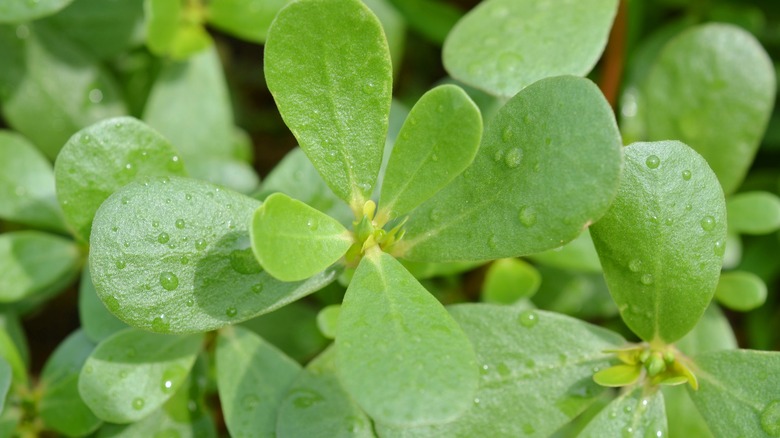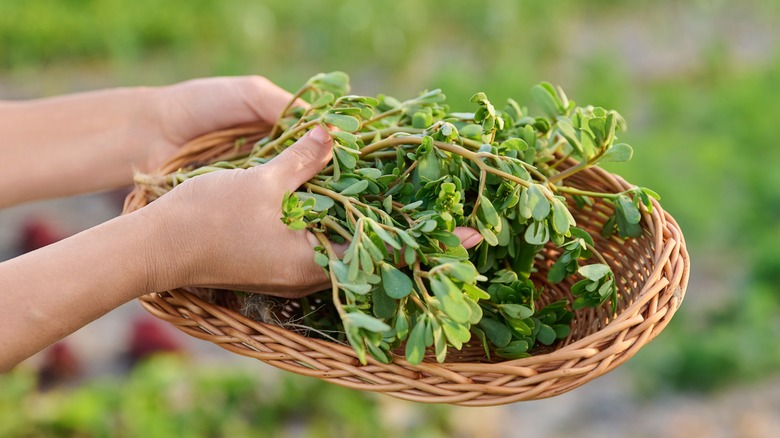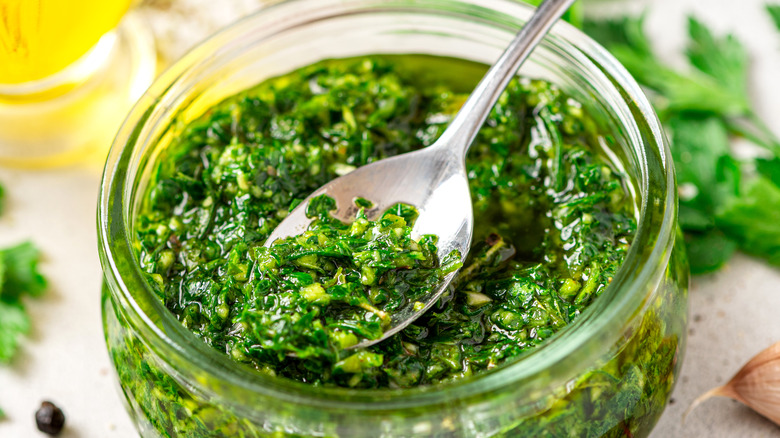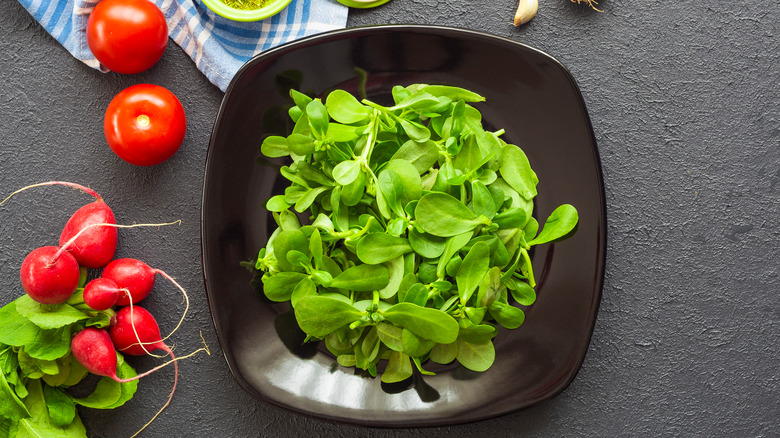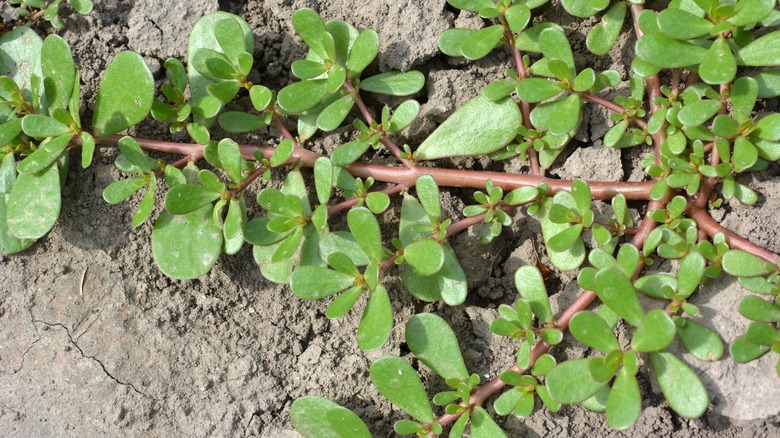Purslane Is The Nutritious Weed You Should Be Eating More Of
When you think of a weed, you likely picture a bothersome bit of greenery that sprouts up in your carefully planned garden or along the edges of your manicured lawn. However annoying and time-consuming it can be to pull weeds out of your green spaces, not all weeds are bad and some can be edible. If you've never heard of edible weeds, you may feel surprised, since many people tend to think of weeds in a negative way.
As reported by Britannica, a weed is considered a "general term for any plant growing where it is not wanted." With that definition in mind, it's easy to believe there are a number of "weeds" we could let grow for their ornamental or even nutritional qualities, such as stinging nettle, or dandelion, which grows prolifically, contains pretty yellow flowers and is edible. It includes making jelly, tea, and using dandelion greens in a salad, as explained by Food 52. Even if you're familiar with eating a dandelion, there's another nutritious weed that may be growing in a park near you, or even in your yard, that you should be eating.
What is purslane?
That wild-growing plant that many people view as a weed is called purslane or portulaca oleracea, per the National Library of Medicine. It has succulent stems that can be either green or sometimes red in color, with flat, thick, fleshy leaves. It's often foraged in public spaces such as parks, meadows, or sometimes in backyards. As with anything else that's foraged, such as wild mushrooms or edible flowers like violets, it's important to know what you're looking for when picking purslane.
According to Homespun Seasonal Living, purslane and another wild-growing plant called spurge look similar, although spurge is a poisonous plant. The article further explains that purslane can be identified by its leaves and slightly woody stems that are reminiscent of a succulent plant to both the eye and touch, spurge lacks a succulent look and feel, and when the stems of each plant are cut into, spurge stems release a white, milky substance and purslane doesn't. Another way to easily identify purslane, as explained by The Foraged Foodie, is the way purslane grows on its stems, in a star-shaped grouping of four leaves.
What it tastes like and how to eat it
Purslane can be eaten raw, as part of a salad, on a sandwich, as a garnish for tacos, or even in place of some herbs and other lettuce. As detailed by Hunter, Angler, Gardener, Cook, purslane has a juicy, tart flavor and a crunchy texture, and explains that although eating it raw is common, purslane can also be lightly sauteed, or enjoyed pickled. Because of the plant's thick, fleshy leaves and tart, somewhat spicy flavor that is reminiscent of arugula, when served as part of a salad, purslane holds up well with herb-infused dressings and citrus vinaigrettes (via The Spruce Eats).
And From A Chef's Kitchen reports that purslane's vibrant green color and bright flavor make it a great replacement for parsley in chimichurri, an herb and vinegar sauce that originates from Argentina. Chimichurri isn't the only thing that can benefit from the addition of purslane since the plant is perfect for swapping out in other sauces and dips that call for greens or herbs. A Modo Mio describes using purslane in a pesto recipe and Hilda's Kitchen replaces spinach with purslane in a creamy, yogurt-based dip.
Health benefits of purslane
Purslane isn't just a wild edible that can be easily swapped in recipes, it's also packed with nutritional value and some medicinal benefits. As reported by Healthline, it's loaded with Vitamins A and C, magnesium, iron, as well as high amounts of Omega 3 fatty acids, which are mainly found in fish, making this a great source of plant-based Omega 3. And Almanac explains that purslane has six times the amount of Vitamin E found in spinach. WebMD details that purslane also contains high amounts of folate, which helps our cells safely divide, and consuming folate while pregnant can also help prevent birth defects.
The plant also has a long history of medicinal uses. According to the National Library of Medicine, purslane can be used to treat coughs, burns, and headaches, as well as in treatments for diseases that impact the liver and intestine. The medicinal uses for purslane don't stop there, as the article further explains it can be used as a muscle relaxer, a diuretic, and as a treatment for psoriasis.
Foraging for purslane or growing it
As reported by MasterClass, foraging is a skill that can be necessary for survival if you're stuck in the wilderness, but foraging is also a skill that some people view as a forgotten resource and are eager to get basic knowledge of. Since purslane is fairly easy to identify and grows in a variety of places, it's a good plant for beginning foragers. Four Seasons Foraging details that purslane grows wild in numerous climates, and it can be found in southern parts of Canada, as well the lower 48 states, and Hawaii.
If you're unable to find purslane in your backyard, at your favorite park, or in an open field, there's still a way to enjoy this nutritious wild edible. One solution is to simply grow it yourself. According to Gardeners' World, you can grow purslane by planting it from a seed, but since it's sensitive to frost be sure to plant it where it can get access to full sun and for best results grow it in soil that drains well. Once you've planted purslane, caring for it is pretty simple, as Gardening Know How explains, purslane flourishes easily and doesn't require a lot of watering. However, it can quickly overtake your garden unless you harvest it regularly. No matter how you attain it, either foraging or growing it yourself, adding purslane to your diet is something you need to try.
